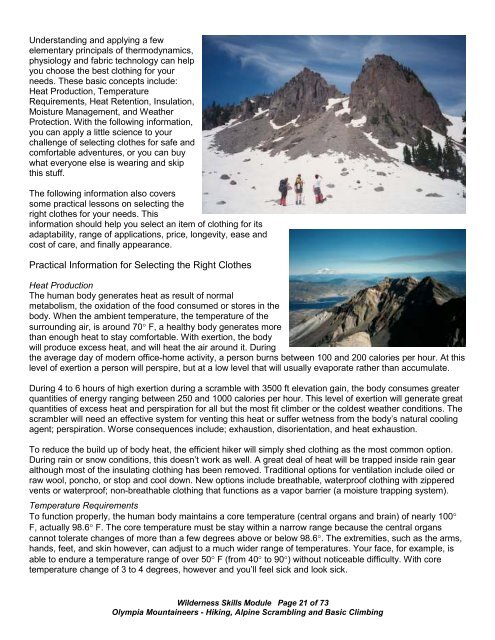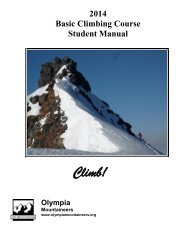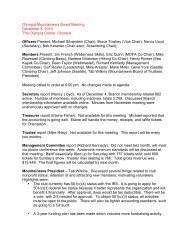Wilderness Skills - Olympia Mountaineers
Wilderness Skills - Olympia Mountaineers
Wilderness Skills - Olympia Mountaineers
Create successful ePaper yourself
Turn your PDF publications into a flip-book with our unique Google optimized e-Paper software.
Understanding and applying a few<br />
elementary principals of thermodynamics,<br />
physiology and fabric technology can help<br />
you choose the best clothing for your<br />
needs. These basic concepts include:<br />
Heat Production, Temperature<br />
Requirements, Heat Retention, Insulation,<br />
Moisture Management, and Weather<br />
Protection. With the following information,<br />
you can apply a little science to your<br />
challenge of selecting clothes for safe and<br />
comfortable adventures, or you can buy<br />
what everyone else is wearing and skip<br />
this stuff.<br />
The following information also covers<br />
some practical lessons on selecting the<br />
right clothes for your needs. This<br />
information should help you select an item of clothing for its<br />
adaptability, range of applications, price, longevity, ease and<br />
cost of care, and finally appearance.<br />
Practical Information for Selecting the Right Clothes<br />
Heat Production<br />
The human body generates heat as result of normal<br />
metabolism, the oxidation of the food consumed or stores in the<br />
body. When the ambient temperature, the temperature of the<br />
surrounding air, is around 70° F, a healthy body generates more<br />
than enough heat to stay comfortable. With exertion, the body<br />
will produce excess heat, and will heat the air around it. During<br />
the average day of modern office-home activity, a person burns between 100 and 200 calories per hour. At this<br />
level of exertion a person will perspire, but at a low level that will usually evaporate rather than accumulate.<br />
During 4 to 6 hours of high exertion during a scramble with 3500 ft elevation gain, the body consumes greater<br />
quantities of energy ranging between 250 and 1000 calories per hour. This level of exertion will generate great<br />
quantities of excess heat and perspiration for all but the most fit climber or the coldest weather conditions. The<br />
scrambler will need an effective system for venting this heat or suffer wetness from the body’s natural cooling<br />
agent; perspiration. Worse consequences include; exhaustion, disorientation, and heat exhaustion.<br />
To reduce the build up of body heat, the efficient hiker will simply shed clothing as the most common option.<br />
During rain or snow conditions, this doesn’t work as well. A great deal of heat will be trapped inside rain gear<br />
although most of the insulating clothing has been removed. Traditional options for ventilation include oiled or<br />
raw wool, poncho, or stop and cool down. New options include breathable, waterproof clothing with zippered<br />
vents or waterproof; non-breathable clothing that functions as a vapor barrier (a moisture trapping system).<br />
Temperature Requirements<br />
To function properly, the human body maintains a core temperature (central organs and brain) of nearly 100°<br />
F, actually 98.6° F. The core temperature must be stay within a narrow range because the central organs<br />
cannot tolerate changes of more than a few degrees above or below 98.6°. The extremities, such as the arms,<br />
hands, feet, and skin however, can adjust to a much wider range of temperatures. Your face, for example, is<br />
able to endure a temperature range of over 50° F (from 40° to 90°) without noticeable difficulty. With core<br />
temperature change of 3 to 4 degrees, however and you’ll feel sick and look sick.<br />
<strong>Wilderness</strong> <strong>Skills</strong> Module Page 21 of 73<br />
<strong>Olympia</strong> <strong>Mountaineers</strong> - Hiking, Alpine Scrambling and Basic Climbing




